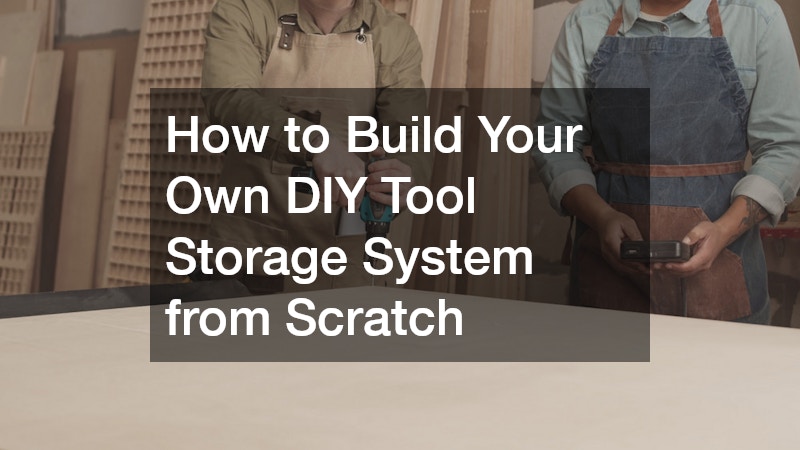
Tools are a homeowner’s best friend, but without proper organization, they can quickly turn your garage or workshop into a cluttered mess. A DIY tool storage system offers a practical and cost-effective solution to keeping your space tidy, functional, and ready for any project. Whether you’re a seasoned DIYer or just starting out, building your own storage system from scratch allows you to customize it to your space, your tools, and your workflow.
In this guide, we’ll walk you through how to design, plan, and build your very own DIY tool storage system step by step. We’ll also touch on useful tool storage ideas and tips that can enhance your setup, making it both efficient and visually satisfying. Let’s get started on creating a space where every tool has a home.
What Should You Consider Before Building?

Before grabbing your saw or hammer, it’s important to consider a few key elements that will guide the design of your DIY storage system:
- Available Space: Measure your garage, shed, or workspace. Take note of walls, ceilings, and corners that can be utilized.
- Tool Inventory: Categorize your tools—hand tools, power tools, gardening tools, etc. This helps determine what kind of storage you need.
- Frequency of Use: Store frequently used tools in easy-to-reach spots and seldom-used tools higher up or in drawers.
- Budget: A DIY system can be budget-friendly, but planning helps avoid overspending on materials.
- Skill Level: Choose a design that matches your carpentry experience. Simple pegboards and shelves are great for beginners.
Taking the time to evaluate these factors will result in a system that truly works for your lifestyle.
Step-by-Step: How to Build a DIY Tool Storage System from Scratch
Building your own tool storage isn’t just about utility—it’s about creating a system that complements your workflow. Here’s how to do it:
1. Design Your Layout
Sketch a rough layout of your storage system. This might include:
- A pegboard for small hand tools
- A workbench with drawers
- Shelves for toolboxes and power tools
- Wall-mounted racks for long tools
Use grid paper or a digital design tool to map out the dimensions. Factor in space for walking and working.
2. Choose the Right Materials
Common choices include:
- Plywood: Strong, affordable, and easy to work with
- 2x4s or 1x4s: Great for framing shelves and supports
- Pegboard: Ideal for organizing hand tools
- Metal brackets: For securing shelves or wall racks
Use quality screws and wall anchors for added safety and durability.
3. Build the Framework
Start by installing the base of your system, such as a bench or base cabinet. Then, build upward with shelving units or wall-mounted systems.
- Secure wall-mounted items into studs
- Use level tools to ensure everything is straight
- Sand edges to prevent splinters
4. Add Storage Components
Incorporate the features that will make your storage truly functional:
- Drawer organizers for drill bits and fasteners
- Hooks or pegs for hanging items
- Clear bins for small parts and supplies
- Magnetic strips for screwdrivers or pliers
Label everything to make retrieval easier.
5. Paint or Seal the Wood
While not necessary, painting or sealing your wood components can protect them from humidity and wear. It also makes your workspace feel cleaner and more professional.
Where Can You Find Inspiration for Tool Storage Ideas?
If you’re unsure how to structure your design, you’re not alone. There are countless tool storage ideas available online that can spark your creativity. Popular sources include:
- Pinterest boards featuring compact garage setups
- YouTube channels that offer visual walkthroughs
- DIY blogs and forums
- Home improvement magazines
Don’t hesitate to combine multiple ideas into one system. A good DIYer knows how to take inspiration and make it their own.
How Can You Maximize Space in a Small Workshop?
Not everyone has a huge garage to work with—but that doesn’t mean you can’t build an efficient system.
Here are a few smart tips to maximize every inch:
- Use wall and ceiling space for hanging tools or overhead bins
- Install fold-down workbenches to save space when not in use
- Repurpose old furniture like bookshelves or cabinets
- Stack vertically—tall shelving units help store more in less floor space
- Label and group tools by category for easy access
With a little creativity, even the smallest areas can become well-organized tool stations.
Why Building Your Own Storage System Is Worth It

Sure, you can buy pre-made tool organizers—but building your own has several advantages:
- Customization: Tailor it to your exact needs and available space
- Cost savings: Save money by using leftover or reclaimed materials
- Skill development: Improve your woodworking and planning skills
- Satisfaction: There’s nothing more rewarding than building a functional piece with your own hands
Plus, every time you reach for a tool, you’ll feel the satisfaction of knowing the system is your own creation.
Final Thoughts
A DIY tool storage system doesn’t have to be complicated or expensive. With a bit of planning, the right materials, and a weekend of effort, you can build a storage solution that’s tailored to your space, your tools, and your personal working style. Start small, stay organized, and keep improving your setup as your needs evolve.

